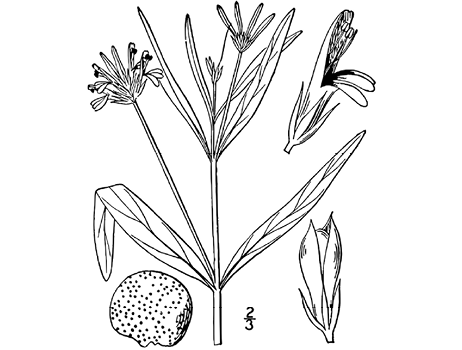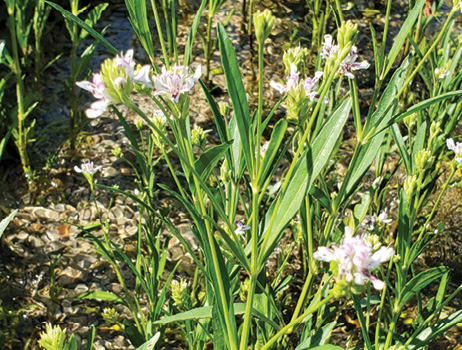Water-willow | Justicia americana
Emergent | Native



Water-willow, also known as American water-willow, is found throughout the eastern half of the United States. This species grows from slender rhizomes that expand over time to form large stands. You will most often find this plant along the shoreline, in shallow lakes and ponds, or in the shallow riffles of flowing water.
Stems may emerge 3 feet above water and have simple leaves that are arranged oppositely along the stem. Leaves are normally 3 to 6 inches when mature, sword-shaped, and medium-green.
Water-willow is sometimes confused with alligator weed, but it can be distinguished by its single showy, white and/or violet iris-like flowers. Alligator weed typically has spherical, clover-like, white flowers. Water-willow flowers produce dry, highly polished seeds in groups of four, and each seed is about one-tenth of an inch in length.
Management Value
Water-willow is a native species and an important component of natural waterbodies. Deer will eat the leaves, beavers and muskrats will eat the rhizomes, and bees and other insects use the pollen. In moderate densities, it makes excellent habitat for fish, amphibians, and aquatic invertebrates.
The growth rate of water-willow is moderate to rapid, quickly forming large colonies. It can be problematic in shallow ponds and should not be encouraged by most pond owners. However, for those who like aggressive management, it makes excellent fish habitat and can be introduced on small, shallow areas adjacent to deeper water. Take care to control any unwanted expansion early before the colonies grow to nuisance levels.
Recommended Controls
Option 1: 2,4-D (3.8-pound formulation). For each gallon of water, mix 1.0 ounce of 2,4-D and 1.3 ounces of non-ionic surfactant. Spray to wet all plants. Do not exceed annual herbicide rate limits as stated on the product label.
The best approach is to treat ponds with herbicides when the plants are actively growing and the water temperature is at least 60˚F. Multiple applications may be necessary to achieve eradication.
Read and follow all chemical label instructions, especially the section on the use of personal protection equipment.
Photo Credits Top: Mike Cline, Creative Commons; Middle: N. L. Britton and A. Brown, USDA.

The information given here is for educational purposes only. References to commercial products, trade names, or suppliers are made with the understanding that no endorsement is implied and that no discrimination against other products or suppliers is intended.
Publication 3735-41 (POD-11-23)
By Wes Neal, PhD, Extension/Research Professor, Wildlife, Fisheries, and Aquaculture; Dennis Riecke, Fisheries Coordinator, Mississippi Department of Wildlife, Fisheries, and Parks; and Gray Turnage, PhD, Assistant Research/Extension Professor, GeoSystems Research Institute.
The Mississippi State University Extension Service is working to ensure all web content is accessible to all users. If you need assistance accessing any of our content, please email the webteam or call 662-325-2262.



